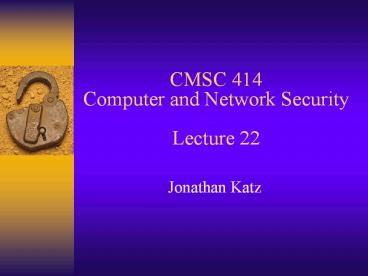CMSC 414 Computer and Network Security Lecture 22 - PowerPoint PPT Presentation
1 / 21
Title:
CMSC 414 Computer and Network Security Lecture 22
Description:
CMSC 414 Computer and Network Security Lecture 22 Jonathan Katz Network layers Application Transport Network Data link Physical Roughly Application layer: the ... – PowerPoint PPT presentation
Number of Views:93
Avg rating:3.0/5.0
Title: CMSC 414 Computer and Network Security Lecture 22
1
CMSC 414Computer and Network SecurityLecture 22
- Jonathan Katz
2
Network security in practice
3
Network layers
- Application
- Transport
- Network
- Data link
- Physical
4
Roughly
- Application layer the communicating processes
themselves and the actual messages transmitted - Transport layer handles transmissions on an
end-to-end basis - Network layer handles transmissions on a
hop-by-hop basis
5
Examples
- Application layer PGP, SSH
- Transport layer SSL/TLS
- Network layer IPsec
- Security not usually provided at the data link
layer, except possible within closed networks
(e.g., military) - Security at the physical layer? (Shielded wires)
6
Security in what layer?
- Depends on the purpose
- What information needs to be protected?
- What is the attack model?
- Who shares keys in advance?
- Should the user be involved?
- E.g., a network-layer protocol cannot
authenticate two end-users to each other - An application-layer protocol cannot protect IP
header information - Also affects efficiency, ease of deployment, etc.
7
Example PGP vs. SSL vs. IPsec
- PGP is an application-level protocol for secure
email - Can provide security on insecure systems
- Users choose when to use PGP user must be
involved - Alices signature on an email proves that Alice
actually generated the message, and it was
received unaltered also non-repudiation - In contrast, SSL would secure the connection
from Alices computer
8
Example PGP vs. SSL vs. IPsec
- SSL sits on top of the transport layer
- End-to-end security, best for connection-oriented
sessions - User does not need to be involved
- The OS does not have to be changed
- Easy to modify applications to use SSL
- If SSL rejects packet accepted by TCP, then TCP
rejects correct packet when it arrives! - SSL must then close the connection
9
Example PGP vs. SSL vs. IPsec
- IPsec sits on top of the network layer
- End-to-end or hop-by-hop security
- Best for connectionless channels
- Need to modify OS
- All applications are protected by default,
without requiring any change to applications or
actions on behalf of users - Can only authenticate hosts, not users
- User completely unaware that IPsec is running
10
Take home message
- Best solution may involve changes at both the OS
and applications layers - The best solution is not to run SSL and IPsec!
- Would have been better to design system with
security in mind from the beginning - (Keep in mind for future systems)
11
IPsec AH and ESP
12
Overview
- IPsec consists of two components
- AH/ESP
- Used once a key is established (either using IKE
or out-of-band) - IKE
- Can be used to establish a key
13
Security associations (SAs)
- An SA is a crypto-protected connection
- One SA in each direction
- At each end, the SA contains a key, the identity
of the other party, the sequence number, and
crypto parameters - IPsec header indicates which SA to use
- Chosen by destination
- Wont go into more detail
14
More on SAs
- Parties will maintain a database of SAs for
currently-open connections - Used both to send and receive packets
15
AH vs. ESP
- Authentication header (AH)
- Provides integrity only
- Encapsulating security payload (ESP)
- Provides encryption and/or integrity
- Both provide cryptographic protection of
everything beyond the IP headers - AH additionally provides integrity protection of
some fields of the IP header
16
Transport vs. tunnel mode
- Transport mode add IPsec information between IP
header and rest of packet - IP header IPsec packet
- Most logical when IPsec used end-to-end
17
Transport vs. tunnel mode
- Tunnel mode keep original IP packet intact add
new header information - New IP header IPSec old header packet
- Can be used when IPSec is applied at intermediate
point along path (e.g., for firewall-to-firewall
traffic) - E.g., change source/destination info
- Results in slightly longer packet
- Note that data may be encrypted multiple times
18
Firewalls
- Problem if data used for decision-making (like
higher-layer information) is encrypted end-to-end - Arguments pro and con as to whether this data
should be encrypted or not
19
More on AH
- AH provides integrity protection on header
- But some fields change en route!
- Only immutable fields are included in the
integrity check - Mutable but predictable fields are also included
in the integrity check - E.g., payload length
- The final value of the field is used
20
More on AH vs. ESP
- Recall that ESP provides encryption and/or
authentication - So why do we need AH?
- AH also protects the IP header
- Export restrictions
- Firewalls need some high-level data to be
unencrypted - None of these are compelling
21
The future of IPsec?
- In the long run, it seems that AH will become
obsolete - Better to encrypt everything anyway
- No real need for AH
- Certain performance disadvantages
- AH is complex
- Etc.
- IPsec is still evolving































